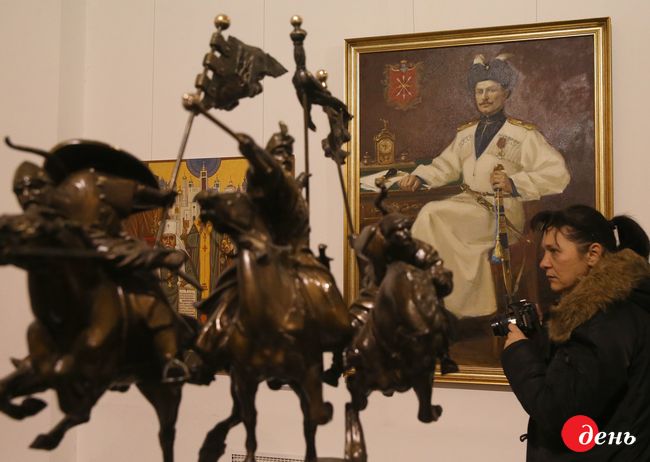History in colors
Biennale “Ukraine from Trypillia until Today” continues to acquaint us with our own past
It was impossible to imagine an event like this even 30 years ago. Monumental pictures with Kruty defenders and UPA fighters, portraits of Mykhailo Hrushevsky, Pavlo Skoropadsky, and Vasyl Stus can be seen at the 8th All-Ukrainian Biennale of Historical Art “Ukraine from Trypillia until Today in the Works of Contemporary Artists.” The event is devoted to the 100th anniversary of the proclamation of the Ukrainian National Republic.
The exposition shows about 300 works by almost 200 authors from all the nooks of Ukraine. By tradition, artist Oleksandr Melnyk is the exhibit’s curator. The biennale is held in the exhibition halls of the National League of Ukrainian Artists’ Central House of the Artist.
PERSONAL DIMENSION OF A MUTUAL TRAGEDY
“I saw a picture at the National Art Museum in the Soviet era, which depicts kulaks with sawn-off guns – terrible and grotesque images. They have already killed one man from the grain-confiscation unit, and his comrade, still alive, is defending sacks on the cart. They pictured a villain who robbed people as a hero. Is my grandfather, who was reduced to poverty, such a villain? This is the personal reason why I took up this project. Another reason is that our history was always twisted. I wanted artists to show the truth of it,” Melnyk says.”

One of the biennale pictures is Melnyk’s “Ukrainian Christmas under the Red Star.” It is based on his mother’s reminiscences and explains why the subject of kulaks’ dispossession stirred him so much. “I combined on the canvas the events that took place at different times. A grain procurement plan was imposed, and my grandfather’s household fulfilled it. Then the plan was increased. My kin had almost nothing to fulfill it. My grandfather was arrested and imprisoned at the district center. They explained to him that they wouldn’t free him unless he delivered what was required. Granddad wrote to grandma perhaps under dictation: ‘Natalka, borrow something, otherwise they won’t release me.’ She went to borrow,” Melnyk says, telling his family history.

The artist adds that villagers respected his grandfather very much. “Komnezam [Poor Peasants’ Committees. – Ed.] people wouldn’t come into his house without knocking, and they would take off their hats to him. Then some armed bosses came from the district center, and Komnezam guys went against the whole family,” Melnyk continues. “The picture shows a winged boy, as if he were a Christmas angel. It is my uncle who was thrown bodily out of the house. They threw out a cradle with a baby right on the snowy ground. My kin – cultured and laborious people – were turned into beggars.”
“WE BOTH MAKE AND REMAKE OUR HISTORY”
The exhibit displays the works of both noted authors and students. Incidentally, Melnyk, who is always busy looking for project sponsors, found it possible to help the young artists. Businessman Volodymyr Kolinko earmarks 30,000 hryvnias for scholarships to 10 students who make historically-themed works.

In addition to depicting events of the distant past, biennale participants reflected on the ongoing war in Ukraine. According to Melnyk, artists are making and remaking our history. For example, Maryna Sochenko, who has drawn about 60 pictures of Euromaidan participants, worked in the east for several weeks and executed a series of soldiers’ portraits.
Besides, you can see the works of the winners of the open poster competition “1917-2017” at the “Maisternia” gallery on the ground floor of the Central House of the Artist. It displays posters from 17 countries, from Azerbaijan to Chile.
“THEY ARE KILLING US BECAUSE THE STATE DOESN’T NEED US”
The exhibit could be more variegated. The point is that some artists, whose works were selected for the biennale, lacked funds to deliver their canvases. The exhibit has always relied exclusively on the enthusiasm of artists themselves. “They are killing us because the state doesn’t need us,” Melnyk emphasizes. “They give money for cinema, thank God, and you can see its renaissance. But don’t we need fine arts? A pressure group is going soon to write a letter to the minister of culture so that they also allocate something for figurative art.”

But, in spite of unwelcome tendencies, biennale participants have already discussed the theme of the next exhibit.
Historical memory, which was and still is being destroyed, can be compared to the baby on the snow in Melnyk’s picture. The 8th All-Ukrainian Biennale “Ukraine from Trypillias until Today in the Works of Contemporary Artists,” open until February 4, is helping save it.






